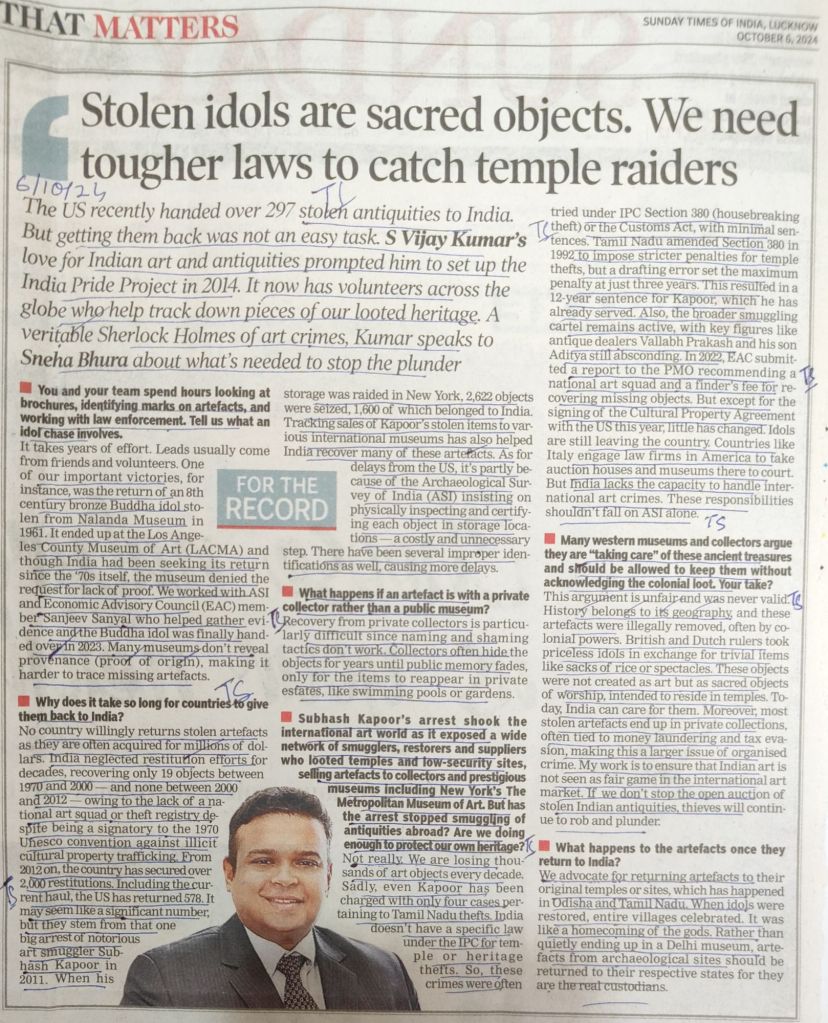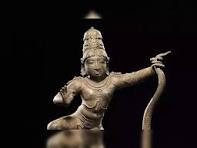Copyright@shravancharitymission
INTERESTING FACTS: STOLEN IDOLS ARE SACRED OBJECTS. WE NEED TOUGHER LAWS TO CATCH TEMPLE RAIDERS. (THE TIMES OF INDIA 6/10/24)
The US recently handed over 297 stolen antiquities to India. But getting them back was not an easy task. S Vijay Kumar’s love for Indian art and antiquities prompted him to set up the India Pride Project in 2014. It now has volunteers across the globe who help track down pieces of our looted heritage. A veritable Sherlock Holmes of art crimes, Kumar speaks to Sneha Bhura about what’s needed to stop the plunder.
Q. You and your team spend hours looking at brochures, identifying marks on artefacts, and working with law enforcement. Tell us what an idol chase involves.
A. It takes years of effort. Leads usually come from friends and volunteers. One of our important victories, for instance, was the return of an 8th-century bronze Buddha idol stolen from the Nalanda Museum in 1961. It ended up at the Los Angeles County Museum of Art (LACMA), and though India had been seeking its return since the ’70s itself, the museum denied the request for lack of proof. We worked with the ASI and Economic Advisory Council (EAC) member Sanjeev Sanyal, who helped gather evidence and the Buddha idol was finally handed over in 2023. Many museums don’t reveal provenance (proof of origin), making it harder to trace missing artefacts.
Q. Why does it take so long for countries to give them back to India?
A. No country willingly returns stolen artefacts as they are often acquired for millions of dollars. India neglected restitution efforts for decades, recovering only 19 objects between 1970 and 2000—and none between 2000 and 2012—owing to the lack of a national art squad or theft registry despite being a signatory to the 1970 UNESCO convention against illicit cultural property trafficking. From 2012 on, the country has secured over 2,000 restitutions. Including the current haul, the US has returned 578. It may seem like a significant number, but they stem from that one big arrest of notorious art smuggler Subhash Kapoor in 2011. When his storage was raided in New York, 2622 objects were seized, 1600 of which belonged to India. Tracking sales of Kapoor’s stolen items to various international museums has also helped India recover many of these artefacts. As for delays from the US, it’s partly because of the Archaeological Survey of India (ASI) insisting on physically inspecting and certifying each object in storage locations—a costly and unnecessary step. There have been several improper identifications as well, causing more delays.
Q. What happens if an artefact is with a private collector rather than a public museum?
A. Recovery from private collectors is particularly difficult since naming and shaming tactics don’t work. Collectors often hide the objects for years until public memory fades, only for the items to reappear in private estates, like swimming pools or gardens.
Q. Subhash Kapoor’s arrest shook the international art world as it exposed a wide network of smugglers, restorers and suppliers who looted temples and low-security sites, selling artefacts to collectors and prestigious museums including New York’s The Metropolitan Museum of Art. But has the arrest stopped the smuggling of antiquities abroad? Are we doing enough to protect our own heritage?
A. Not really. We are losing thousands of art objects every decade. Sadly, even Kapoor has been charged with only four cases pertaining to Tamil Nadu thefts. India doesn’t have a specific law under the IPC for temple or heritage theft. So, these crimes were often tried under IPC Section 380 (housebreaking theft) or the Customs Act, with minimal sentences. Tamil Nadu amended Section 380 in 1992 to impose stricter penalties for temple thefts, but a drafting error set the maximum penalty at just three years. This resulted in a 12-year sentence for Kapoor, which he has already served. Also, the broader smuggling cartel remains active, with key figures like antique dealers Vallabh Prakash and his son Aditya still absconding. In 2022, EAC submitted a report to the PMO recommending a national art squad and a finder’s fee for recovering missing objects. But except for the signing of the Cultural Property Agreement with the US this year, little has changed. Idols are still leaving the country. Countries like Italy engage law firms in America to take auction houses and museums there to court. But India lacks the capacity to handle international art crimes. These responsibilities shouldn’t fall on ASI alone.
Q. Many Western museums and collectors argue they are “taking care” of these ancient treasures and should be allowed to keep them without acknowledging the colonial loot. Your take?
A. This argument is unfair and was never valid. History belongs to its geography, and these artefacts were illegally removed, often by colonial powers. British and Dutch rulers took priceless idols in exchange for trivial items like sacks of rice or spectacles. These objects were not created as art but as sacred objects to worship, intended to reside in temples. Today, India can care for them. Moreover, most stolen artefacts end up in private collections, often tied to money laundering and tax evasion, making this a large issue of organised crime. My work is to ensure that Indian art is not seen as fair game in the international art market. If we don’t stop the open auction of stolen Indian antiquities, thieves will continue to rob and plunder.
Q. What happens to the artefacts once they return to India?
A. We advocate for returning artefacts to their temples or sites, which has happened in Odisha and Tamil Nadu. When idols were restored, entire villages celebrated. It was like the homecoming of the gods. Rather than quietly ending up in a Delhi museum, artefacts from archaeological sites should be returned to their respective states, for they are the real custodians. (TIMES OF INDIA, OCTOBER 6, 2024).
Posted by Kamlesh Tripathi
Author, Poet, & Columnist
*
https://kamleshsujata.wordpress.com
*
Like it and Share it
*
Shravan Charity Mission is an NGO that works for poor children suffering from life-threatening diseases, especially cancer. Our posts are meant for our readers, including children and adults, and have a huge variety of content. We also accept donations for our mission. Should you wish to donate to the cause of cancer? The bank details are given below:
NAME OF ACCOUNT: SHRAVAN CHARITY MISSION
Account no: 680510110004635 (BANK OF INDIA)
IFSC code: BKID0006805
***






